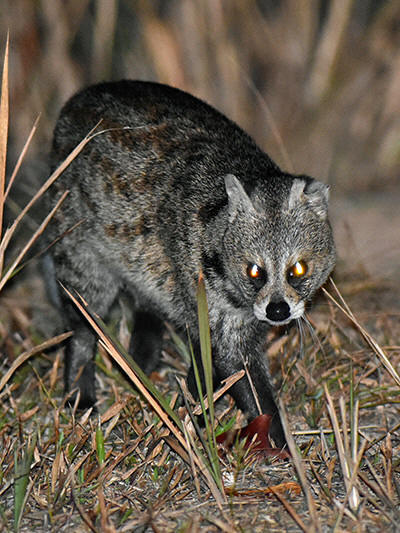 |
Order : CARNIVORA
Family : Viverridae
Species : Viverricula indica
Head-body length : 53-64 cm
Tail length : 30-43 cm
Weight : up to 4 kg
The Small Indian Civet, or Little Civet, inhabits
non-forest areas such as grassland, secondary scrub and disturbed,
agricultural areas. It is mainly nocturnal and generally terrestrial, but
can climb well if needed.
It has a broad, omnivorous diet which includes small vertebrates (reptiles,
amphibians, small mammals, birds), invertebrates (large insects) and some
fruits and roots.
In comparison with other civets in the region, this species is medium in
size, being somewhat larger than the mainly arboreal
Small-toothed Palm Civet, but smaller than the
Malay Civet and other species of the genus Viverra.
Its body is of typical civet shape, but its legs are rather short. Its tail
is relatively thick, and its head is relatively small and narrow.
Its fur is grey or buff, patterned with rows of dark grey or brownish-grey
spots which coalesce to form broken stripes. The tail has between 6 and 9
dark bands, and a pale tip. The throat is pale with indistinct, dark, narrow
bands.
In Southeast Asia this civet occurs in Myanmar, Thailand, Cambodia,
Laos, Vietnam, Peninsular Malaysia, Sumatra, Java and Bali.
Outside the region the species also occurs in much of the Indian
Subcontinent (India, Nepal, Bangladesh etc.) and southern China.
Figs 1 to 3 : Three images of a specimen in dry grassland at Khao Yai,
central Thailand. Photos thanks to Lioe Kim Swee.
References :
Francis, C.M. 2019. A Field Guide to the Mammals of South-east Asia.
Second Edition. New Holland. 416 pp.
Lekagul, B., McNeely, J., 1977. Mammals of Thailand. Association for the
Conservation of Wildlife, Thailand. 758 pp.
|